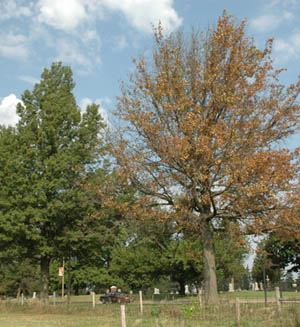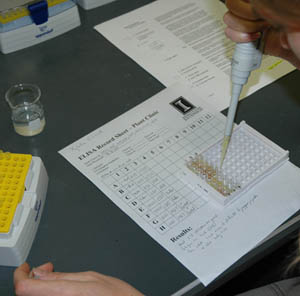Oak Bacterial Leaf Scorch Confirmations | |
|---|---|
| October 22, 2008 | |
|
Bacterial leaf scorch (BLS) sounds rather harmless. Most of us in the green industry think of a scorch problem as browning of leaf edges or possibly some stem tip dieback. That is not incorrect. Leaf scorch, caused by many factors (site, environmental, and cultural), is discussed in the Report on Plant Disease, “Leaf Scorch of Woody Plants,” available online at http://www.aces.uiuc.edu/~vista/abstracts/a620.html. BLS symptoms may appear like any other scorched tree the first year or two. Symptoms become progres- sively worse, usually alarming the owners after a few years. BLS eventually kills the infected tree. I have reported that this takes 6 to 8 or more years, but it is difficult to know exactly how long it takes because we don’t know when infection first occurs. It does appear that trees die 6 to 8 years after alarming symptoms are noted. I have watched this happen to two specific oak trees in Champaign-Urbana. One was about 50 years old. The other is much older and is still declining. For details about BLS, start by viewing the article “Does Your Tree Have BLS?” in issue 15 (2008) of this newsletter and then follow suggested links. The image shows a healthy pin oak next to one with the late stages of BLS.  Typically bacteria can be detected in the lab by sectioning tissue and observing bacterial exudate with a compound microscope. Low levels of the bacterium can be detected by culturing tissue onto agar. These common lab procedures do not detect Xylella, the BLS bacterium. ELISA (enzyme-linked immunosorbant assay) is used to confirm the presence of this bacterium. The image shows an ELISA plate being loaded with sample extracts to be tested.  You may be more familiar with ELISA tests to detect various viral pathogens. It is the same lab technique. The University of Illinois Plant Clinic runs the BLS ELISA only in the late summer and early fall. In part, this allows us to bulk samples and offer the assay at a more economical fee. More importantly, bacterial concentration is usually high at this time of year, resulting in a greater number of definitive assays. This year, we assayed 22 oak samples for Xylella fastidiosa, the pathogen causing bacterial leaf scorch (BLS). We used ELISAs. Keep in mind that the samples do not represent a survey of Illinois. They were sent to us by individuals who have noticed suspect scorch symptoms on mature oaks and wanted to have them tested for the BLS pathogen. We confirmed seven cases of BLS. These oaks came from Champaign, Douglas, and Madison counties. Often, the oak species information is not provided to us. Of the seven positive cases, one was a northern red oak, one a swamp white oak, one a pin oak, and the other four unidentified but certainly in the red oak group. We do not have any additional information on disease management to offer. Still, positive identification is always the first step to any disease management. If you see symptoms as described here, consider testing for BLS late next summer. | |
| Author: | Nancy Pataky |
